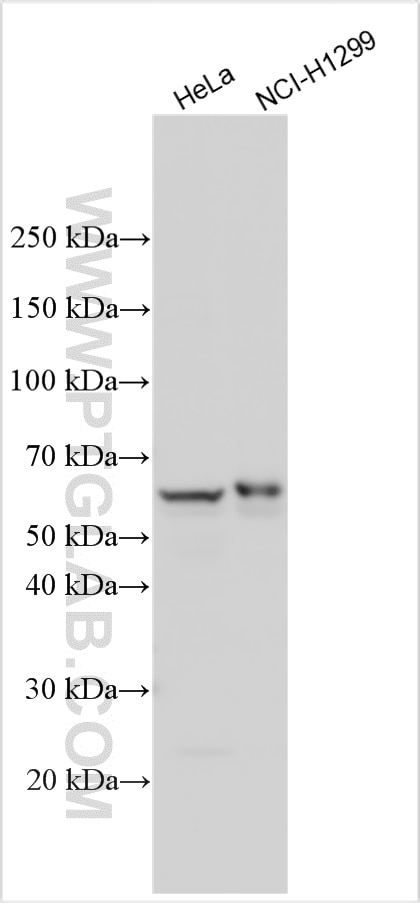Validation Data Gallery
Tested Applications
| Positive WB detected in | HeLa cells, NCI-H1299 cells |
Recommended dilution
| Application | Dilution |
|---|---|
| Western Blot (WB) | WB : 1:1000-1:6000 |
| It is recommended that this reagent should be titrated in each testing system to obtain optimal results. | |
| Sample-dependent, Check data in validation data gallery. | |
Product Information
30999-1-AP targets Glypican-5 in WB, ELISA applications and shows reactivity with human samples.
| Tested Reactivity | human |
| Host / Isotype | Rabbit / IgG |
| Class | Polyclonal |
| Type | Antibody |
| Immunogen | Glypican-5 fusion protein Ag34039 相同性解析による交差性が予測される生物種 |
| Full Name | glypican 5 |
| Calculated molecular weight | 572 aa, 64 kDa |
| Observed molecular weight | 63 kDa |
| GenBank accession number | BC039730 |
| Gene Symbol | Glypican 5 |
| Gene ID (NCBI) | 2262 |
| Conjugate | Unconjugated |
| Form | Liquid |
| Purification Method | Antigen affinity Purification |
| UNIPROT ID | P78333 |
| Storage Buffer | PBS with 0.02% sodium azide and 50% glycerol , pH 7.3 |
| Storage Conditions | Store at -20°C. Stable for one year after shipment. Aliquoting is unnecessary for -20oC storage. |
Background Information
Glypican-5 (GPC5), which is predicted to be located in the cell membrane. In adult, primarily expressed in the brain. Also detected in fetal brain, lung and liver (PMID: 9070915). Glypican-5 is a member of heparan sulfate proteoglycans. The repressive role of GPC5 intumorigenesis has been reported in a variety of cancers, including rhabdomyosarcoma, breast cancer, and prostate cancer. GPC5, which is lowly expressed in lung cancer tissues compared with adjacent noncancerous tissues, exhibits a suppressive effect on migration and invasion, and it can also induce G1/S phase arrest of the lung cancer cells in vitro, which is associated with a better prognosis (PMID: 34079082). The molecular weight of Glypican-5 is 63 kDa.
Protocols
| Product Specific Protocols | |
|---|---|
| WB protocol for Glypican-5 antibody 30999-1-AP | Download protocol |
| Standard Protocols | |
|---|---|
| Click here to view our Standard Protocols |
